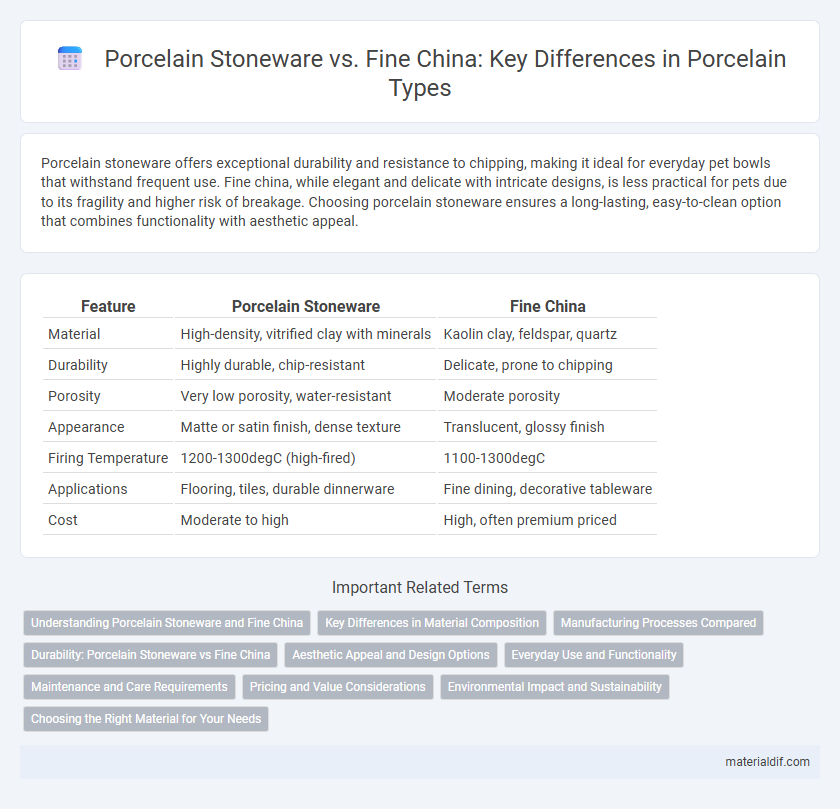Porcelain stoneware offers exceptional durability and resistance to chipping, making it ideal for everyday pet bowls that withstand frequent use. Fine china, while elegant and delicate with intricate designs, is less practical for pets due to its fragility and higher risk of breakage. Choosing porcelain stoneware ensures a long-lasting, easy-to-clean option that combines functionality with aesthetic appeal.
Table of Comparison
| Feature | Porcelain Stoneware | Fine China |
|---|---|---|
| Material | High-density, vitrified clay with minerals | Kaolin clay, feldspar, quartz |
| Durability | Highly durable, chip-resistant | Delicate, prone to chipping |
| Porosity | Very low porosity, water-resistant | Moderate porosity |
| Appearance | Matte or satin finish, dense texture | Translucent, glossy finish |
| Firing Temperature | 1200-1300degC (high-fired) | 1100-1300degC |
| Applications | Flooring, tiles, durable dinnerware | Fine dining, decorative tableware |
| Cost | Moderate to high | High, often premium priced |
Understanding Porcelain Stoneware and Fine China
Porcelain stoneware is a type of dense, durable ceramic fired at high temperatures, known for its strength, resistance to scratches, and suitability for everyday use. Fine china, crafted from kaolin and fired at slightly lower temperatures, offers a delicate, translucent appearance ideal for formal dining settings but requires careful handling. Understanding the differences between porcelain stoneware and fine china helps consumers choose between practical durability and elegant refinement in dinnerware.
Key Differences in Material Composition
Porcelain stoneware is composed of denser, more durable materials like feldspar, kaolin, and quartz, resulting in higher strength and resistance to chipping compared to fine china. Fine china predominantly uses kaolin with a higher percentage of feldspar and is fired at lower temperatures, giving it a more translucent, delicate appearance. The main distinction lies in porcelain stoneware's vitrification process, which produces a non-porous, robust surface, while fine china remains more porous and fragile due to its composition and firing techniques.
Manufacturing Processes Compared
Porcelain stoneware is produced by firing a mixture of clays, quartz, and feldspar at temperatures ranging from 1200degC to 1300degC, resulting in a dense and durable material with low porosity. Fine china, also known as bone china, undergoes a more delicate manufacturing process involving bone ash mixed with kaolin and feldspar, fired at slightly lower temperatures around 1200degC to achieve translucency and whiteness. The key difference lies in the raw materials and firing temperatures, with porcelain stoneware prioritizing strength and resistance, while fine china emphasizes refined appearance and delicate texture.
Durability: Porcelain Stoneware vs Fine China
Porcelain stoneware offers superior durability due to its dense, hard composition and resistance to chipping, scratching, and thermal shock compared to fine china. Fine china, although elegant with a translucent quality, is more prone to cracks and requires careful handling to maintain its pristine condition. The robust nature of porcelain stoneware makes it ideal for everyday use in both residential and commercial settings.
Aesthetic Appeal and Design Options
Porcelain stoneware offers a robust, matte finish often favored for contemporary, minimalist table settings, while fine china boasts a translucent, glossy appearance prized for its elegance and intricate patterns. Porcelain stoneware's design options include textured surfaces and earthy tones, allowing versatile, modern aesthetics suitable for everyday use. Fine china excels in delicate hand-painted details, gold or platinum accents, and classic motifs, enhancing its appeal for formal dining occasions.
Everyday Use and Functionality
Porcelain stoneware offers exceptional durability and resistance to chips and scratches, making it ideal for everyday use in busy households and commercial settings. Fine china, known for its delicate craftsmanship and refined appearance, is better suited for special occasions due to its fragility and higher maintenance requirements. Porcelain stoneware's functionality is enhanced by its non-porous surface, which resists stains and absorbs less water compared to fine china, ensuring long-lasting performance and ease of cleaning.
Maintenance and Care Requirements
Porcelain stoneware requires minimal maintenance due to its dense, non-porous surface that resists stains, scratches, and heat, making it ideal for high-traffic areas and everyday use. Fine china demands delicate handling and careful washing, often requiring hand washing with mild detergents to prevent chipping and maintain its glaze and intricate patterns. Proper storage of fine china involves padded containers or separators to avoid abrasion, whereas porcelain stoneware can be stacked safely with minimal risk of damage.
Pricing and Value Considerations
Porcelain stoneware offers durability and affordability, making it an excellent choice for everyday use without compromising on style. Fine china, valued for its delicate craftsmanship and translucent finish, generally commands a higher price due to the artisanal processes and premium materials involved. Evaluating the balance between cost and long-term usability helps determine whether porcelain stoneware or fine china better suits individual needs and budgets.
Environmental Impact and Sustainability
Porcelain stoneware demonstrates greater environmental sustainability compared to fine china due to its lower firing temperature and higher durability, which reduces resource consumption and waste over time. Fine china typically requires higher energy inputs during production and often contains lead-based glazes, raising concerns about toxicity and environmental pollution. Stoneware's robustness and lower energy footprint make it a preferable eco-friendly choice for consumers prioritizing sustainability in tableware.
Choosing the Right Material for Your Needs
Porcelain stoneware offers exceptional durability and resistance to scratches, making it ideal for everyday use and high-traffic settings, while fine china provides delicate, refined aesthetics suited for formal occasions and display. The choice between porcelain stoneware and fine china depends on balancing the need for practicality with elegance, as stoneware handles heavy use better and fine china excels in visual appeal and intricate craftsmanship. Consider your lifestyle, frequency of use, and maintenance preferences to select the right material that aligns with durability requirements and design sophistication.
Porcelain Stoneware vs Fine China Infographic

 materialdif.com
materialdif.com